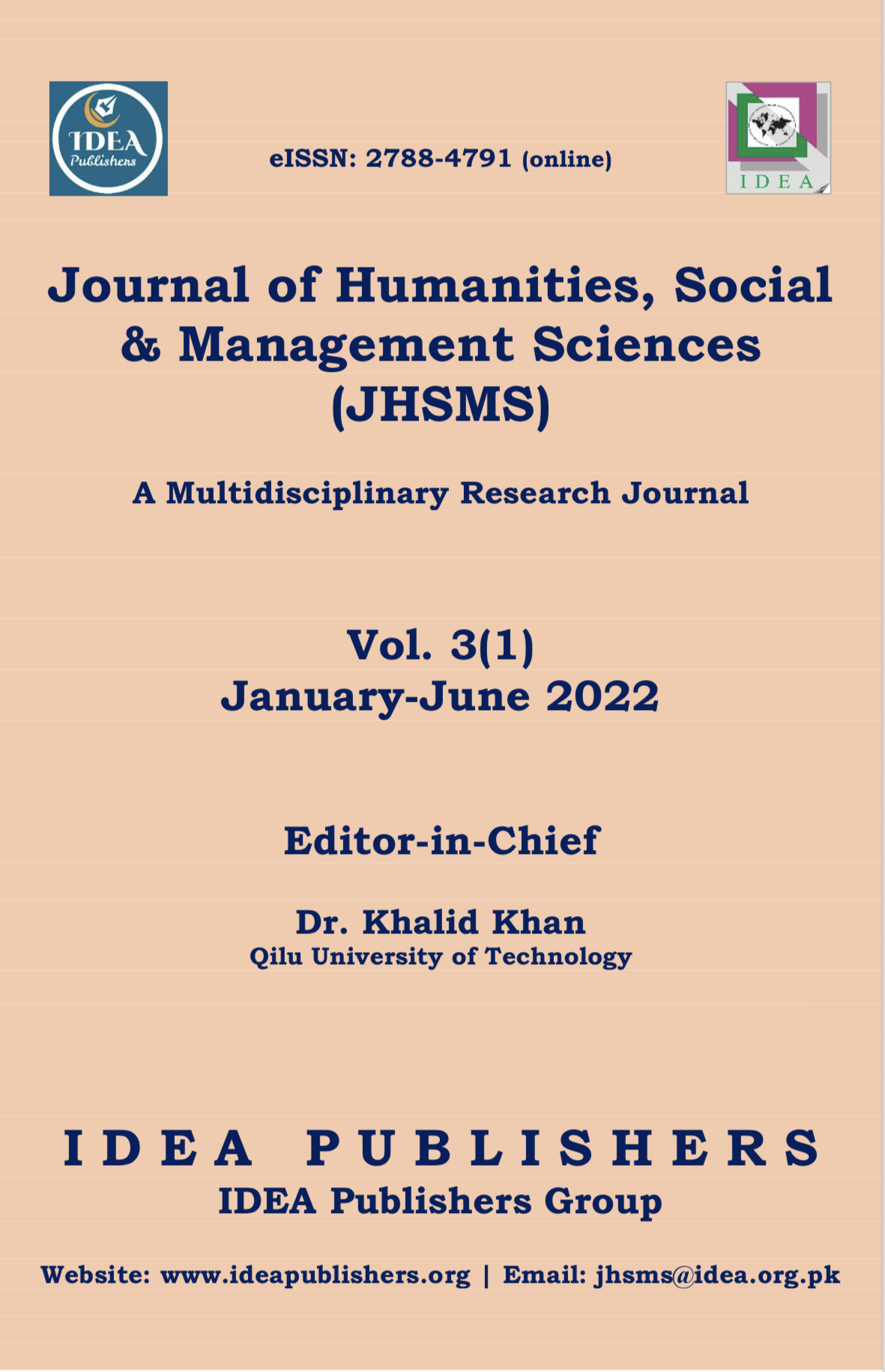Narratology and character functions of Sohni Mahiwal: An actantial analysis
DOI:
https://doi.org/10.47264/idea.jhsms/3.1.11Keywords:
folk tale, actantial model, structure, function, content, social norms, narratives, actant classes, didactic functionAbstract
The study analyses Sohni Mahiwal, the renowned Punjabi folktale, by applying Greimas Actantial model for structural analysis. The purpose of this study is to explore the narrative structure and discover the character functions based on the model. Folktales are considered the simplest and oldest form of stories embedded in the local cultures. They broadly refer to orally transmitted, traditional narratives that carry cultural information. The findings show that all the major actantial categories proposed by Greimas such as subject, object, sender, receiver, helper, and opponent have been depicted in the selected folktale. The analysis revealed that many characters were found involved in several actant classes simultaneously. Structural analysis of the folktale uncovered two parallel acts/episodes. The parallelism in the contents of two acts of the tale serves a didactic function at the socio-cultural level besides entertaining the readers/ listeners proving the strength of true love. As far as the function is concerned, the tale successfully validates the culturally imparted message that the individuals who transgress the social norms are destined to perish.
References
Arvidsson, A. (2006). Vladimir Propp’s fairy tale morphology and game studies: A project sponsored by Vetenskapsrådet. https://www.diva-portal.org/smash/get/diva2:156802/FULLTEXT01.pdf
Aston, E. & Savona, G. (1991). Theatre as sign system: A semiotics of text and performance. Routledge
Azar, E., Abbasi, A., & Azad, V. (2014). The study of the narrative function of two stories from Ilahi-nameh of Attar based on Greimas Pattern and Gerard Genette. Language Related Research, 5(4), 17-43.
Dundes, A. (1963). Structural Typology in North American Indian Folktales. Southwestern Journal of Anthropology, 19(1), 121-130. DOI: https://doi.org/10.1086/soutjanth.19.1.3628926
Eugenio, D. L. (1995). ASEAN Folk Literature: An Anthology. Manila: ASEAN Committee on Culture and Information.
Fischer, J. L. (1963). The Socio-psychological Analysis of Folktales. Current Anthropology, 4(3), 235-295. DOI: https://doi.org/10.1086/200373
Greimas, A. J. (1983). Structural semantics: An attempt at a method. University of Nebraska.
Greimas, A. J. (1983). Reflections on Actantial Models. In Structural Semantics (1966), Chapter 10. Translated by D. McDowell, R. Schleifer, & A. Velie. University of Nebraska.
Greimas, A. J. (1987). On Meaning: Selected Writings in Semiotic Theory. Translated by P. Perron & F.Collins. University of Minnesota.
Griffin, L. J. (1993). Narrative, event-structure analysis, and causal interpretation in historical sociology. American Journal of Sociology, 98, 1094–1133. DOI: https://doi.org/10.1086/230140
Handayani, M. B. (2010). An Application of A. J. Greimas' Structural Analysis on J. R. R Tolkien's The Hobbit. MA Thesis. Padang: Andalas University English Department Faculty of Letter.
Hasanah, U. (2014). Gender Meaning as Narrated in Toni Morrison’s Beloved: Greimas’ Actantial Analysis. MA Thesis. Jember University English Department Faculty of Letters.
Hebert, L. (2006). Tools for Text and Image Analysis: An Introduction to Applied Semiotics. http://www.revue-texto.net/Parutions/Livres-E/Hebert_AS/Hebert_Tools.html
Herman, D. (2000). Existentialist Roots of Narrative Actants. Studies in 20th & 21st Century Literature, 24(2), 5. https://doi.org/10.4148/2334-4415.1484 DOI: https://doi.org/10.4148/2334-4415.1484
Herman, D. (2000). Pragmatic constraints on narrative processing: Actants and anaphora resolution in a corpus of North Carolina ghost stories. Journal of Pragmatics, 32(7), 959-1001. https://doi.org/10.1016/S0378-2166(99)00071-5 DOI: https://doi.org/10.1016/S0378-2166(99)00071-5
Komal, L. (1976). Folk Tales of Pakistan (Vol. 3). Sterling.
Labov, W. (1997). Some further steps in narrative analysis. The Journal of Narrative and Life History, 7 (Special Issue). http://www.ling.upenn.edu/labov/sfs.html. DOI: https://doi.org/10.1075/jnlh.7.49som
Nadeem, F. (2017). Structuralism and Dastan Narratives: Axes of Knowledge, Desire and Power in Hoshruba. Journal of Contemporary Poetics. International Islamic University, Islamabad. DOI: https://doi.org/10.54487/jcp.v1i2.773
Pratami, G. (2016). The Finding of Mr. Right in the Hopeless Romantic’s Handbook Novel Based on Greimas?s Actantial Theory. MA thesis, Universitas Hidayatullah Jakarta, Jakarta, Indonesia). http://repository.uinjkt.ac.id/dspace/handle/123456789/32884
Propp, V. (1968). Morphology of the folktale. (L. Scott, Trans.). University of Texas. DOI: https://doi.org/10.7560/783911
Propp, V. (1984). Theory and history of folklore. Manchester University.
Prayoon, S. (1999). Significance of folktales. http://www. Britanica.com/EBckecked/topic/1212142/folkliterature/237459/folktale
Schleifer, R. (2016). AJ Greimas and the nature of meaning: Linguistics, semiotics and discourse theory. Routledge. DOI: https://doi.org/10.4324/9781315538013
Sharita, Z. U. (2016). The Actantial Analysis and Discussion on Gender Ideology in the Book of Life. MA Thesis. Universitas Indonesia, Indonesia. Retrieved from http://lib.ui.ac.id/file?file=digital/2016-5/20424174-MKYummi%20Zahra%20Sharita.pdf
Swales, J. M. (1990). Genre Analysis: English in Academic and Research Settings. Cambridge University.
Thompson, S. (1946). The folktale. Dryden.
Vilhjálmsdóttir, G., &Tulinius, T. H. (2009). Tales of two subjects: Narratives of career counseling. Journal of Vocational Behavior, 75(3), 267-274. https://doi.org/10.1016/j.jvb.2009.06.008 DOI: https://doi.org/10.1016/j.jvb.2009.06.008
Wang, Y., & Roberts, C. W. (2005). Actantial analysis: Greimas's structural approach to the analysis of self-narratives. Narrative Inquiry, 15(1), 51-74. https://doi.org/10.1075/ni.15.1.04wan DOI: https://doi.org/10.1075/ni.15.1.04wan
Downloads
Published
How to Cite
Issue
Section
License
Copyright (c) 2022 Zareena Qasim, Asifa Qasim

This work is licensed under a Creative Commons Attribution-NonCommercial 4.0 International License.
Please click here for details about the Licensing and Copyright policies of IDEA-PG.















